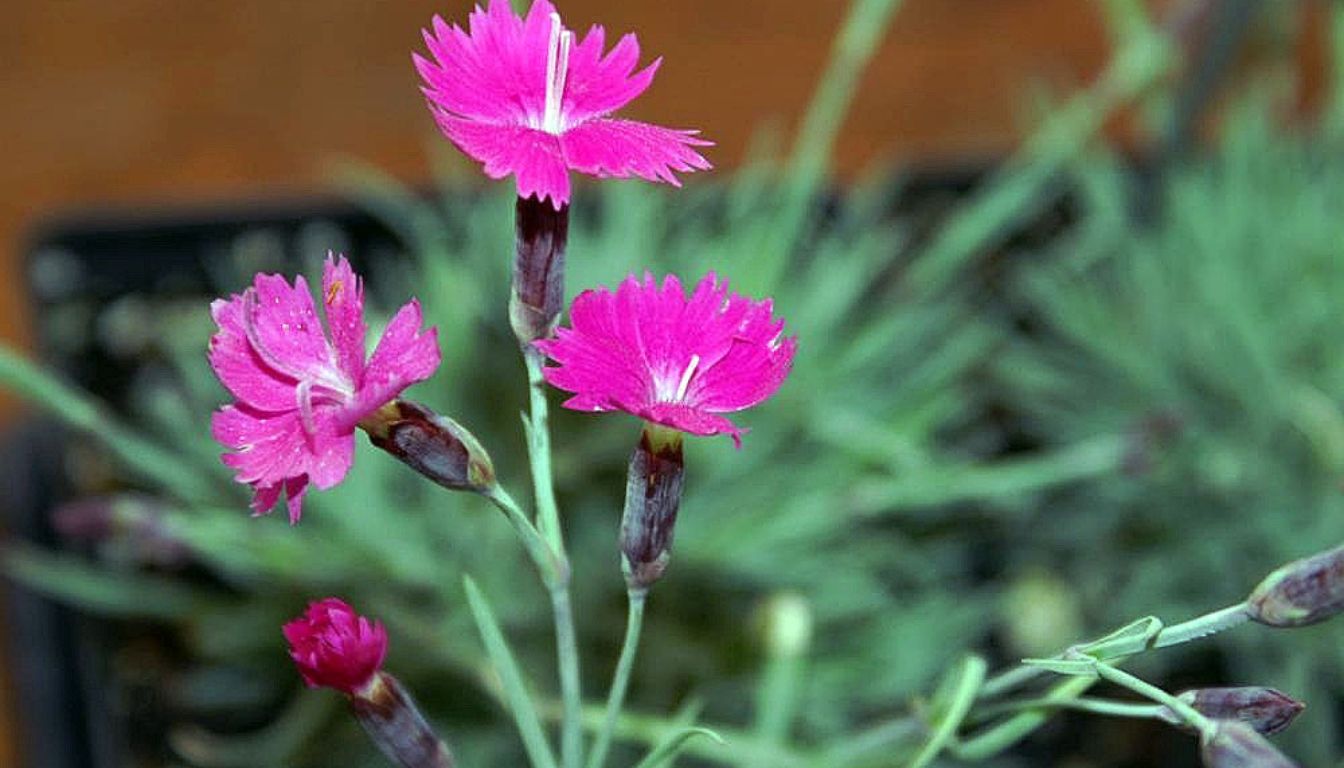If you’re looking to add a touch of elegance and charm to your garden, clove pinks are a must-have. These stunning flowers not only boast vibrant colors but also fill the air with their delightful fragrance. I can’t help but be captivated by their unique beauty and versatility, making them perfect for borders, containers, or even as cut flowers to brighten up your home.
Overview of Clove Pink
Clove pinks stand out in gardens with their bright blooms and sweet scent. These perennial flowers, known scientifically as Dianthus caryophyllus, belong to the carnation family. They grow about 12 to 18 inches tall. Their flower colors range from deep pink to white, often with fringed edges that add charm.
Gardeners love clove pinks for their resilience. They thrive in well-drained soil and prefer full sun. These plants can tolerate drought, making them perfect for low-maintenance gardens. Their ability to bloom repeatedly throughout the growing season adds to their appeal. With proper care, they can flower from early summer to fall.
Clove pinks work well in various garden designs. I often use them in borders or mixed beds. They also shine in containers, bringing color to patios and balconies. As cut flowers, they add a lovely touch to indoor arrangements. Their delicate fragrance enhances any space, making them a favorite among many.
Growing clove pinks can be straightforward. I usually start them from seeds or purchase young plants from nurseries. Planting them in spring or early fall ensures the best results. Fertilizing every few weeks helps them thrive, and deadheading spent flowers encourages more blooms. Caring for clove pinks doesn’t require extensive knowledge; even beginners can enjoy their beauty.
Summarizing, clove pinks are reliable choices for any garden. Their vibrant colors, delightful fragrance, and ease of care make them hard to resist. Whether you’re an experienced gardener or a novice, they can add a touch of elegance to your outdoor space.
Botanical Characteristics
Clove pinks, or Dianthus caryophyllus, exhibit unique qualities that make them standout plants in any garden. These plants present clusters of delicate flowers, each with fringed edges and a captivating mix of colors, including shades of pink and white. Their charming appearance complements a variety of garden designs.
Description of the Plant – How To Grow Clove Pink: Vibrant Flowers for Every Garden
Clove pinks grow to a height of 12 to 18 inches. Each flower boasts a stunning star shape, often filled with a delightful aroma that attracts pollinators. The foliage consists of narrow, gray-green leaves that frame the blooms nicely. I appreciate how these plants create a vibrant display, whether in a border or a container.
Habitat and Growing Conditions
Clove pinks thrive in well-drained soil, which is crucial for their health. They prefer full sun, soaking up rays for optimal growth. Surprisingly, they tolerate drought conditions better than many other flowers. I find it amazing how they bloom from early summer through fall, providing color for months. Regular deadheading and fertilization help maximize their blooming potential. Choosing the right location in the garden ensures these gems flourish beautifully.
Uses of Clove Pink

Clove pinks offer a range of practical applications, from enhancing dishes to providing health benefits.
Culinary Applications – How To Grow Clove Pink: Vibrant Flowers for Every Garden
I often use clove pink petals to add a splash of color and flavor to my dishes. These vibrant petals make eye-catching garnishes for salads and desserts. They possess a spicy-sweet taste that brightens up fruit salads and can add flair to cakes and pastries. When mixed into herbal teas, the flavor profile changes, offering a unique twist. It’s fun to experiment with clove pinks in various recipes, because a little creativity goes a long way in the kitchen.
Medicinal Benefits
Clove pinks aren’t just pretty faces; they also hold potential medicinal benefits. Traditional herbal practices often highlight their properties. Some suggest they may aid digestion when infused in teas. Their antioxidant content might support overall health. I like the idea that these flowers can contribute to wellness while looking beautiful in the garden. Just remember to consult with a healthcare provider before using them for medicinal purposes.
Cultural Significance
Clove pinks carry rich cultural symbolism across various traditions. In many regions, these flowers represent admiration and love. Their vibrant colors have graced floral arrangements in festivals and special occasions for centuries.
People use clove pinks in traditional ceremonies. In some cultures, they symbolize good luck and prosperity. From weddings to birthdays, these flowers add joy and beauty, making events feel more festive. I’ve seen clove pinks brighten up many gatherings, making guests smile.
The culinary world also embraces clove pinks. Their petals not only look beautiful on dishes but also enhance flavors. I love sprinkling them on salads or desserts; they add a dash of color and a subtle spice that catches the eye and pleases the palate.
Medicinally, clove pinks have historical significance too. Many cultures recognize their potential health benefits. Traditional remedies often include these flowers to aid digestion and promote overall wellness. I find it fascinating how plants bring both beauty and health together.
Artists throughout history have also drawn inspiration from clove pinks. Painters and poets alike admire their elegance. Their unique structure and vibrant hues often find a place in artwork, capturing the heart of nature’s beauty.
Overall, clove pinks enrich culture through symbolism, culinary uses, and artistic expression. I appreciate how they intertwine beauty with tradition, making them special in various aspects of life.
Growing Clove Pink in Your Garden
Clove pinks are a fantastic choice for any garden. They bring charm and color effortlessly. I find their ease of growth quite appealing.
Planting and Care Tips – How To Grow Clove Pink: Vibrant Flowers for Every Garden
I recommend starting clove pinks in well-drained soil with plenty of sunlight. Choose a spot that receives at least six hours of sunshine daily. When planting, space them about 8 to 12 inches apart to allow for airflow. If you’re starting from seeds, sow them indoors about 8 to 10 weeks before the last frost date. Transplant them outdoors once the danger of frost has passed.
Water regularly, but avoid waterlogging the soil; these plants prefer to dry out a bit between waterings. Deadhead spent blooms often to encourage more flowers. Fertilize with a balanced fertilizer every four to six weeks to support growth. With a bit of care, clove pinks bloom brightly from early summer through fall, creating a stunning display.
Before You Go – How To Grow Clove Pink: Vibrant Flowers for Every Garden

Clove pinks are more than just beautiful flowers; they bring a unique blend of color, fragrance and versatility to any garden. Their ability to thrive in various conditions makes them a favorite among gardeners like me. Whether I’m using them in a floral arrangement or enjoying their culinary benefits, clove pinks never fail to impress.
Their rich cultural significance adds another layer of appreciation for these blooms. From symbolizing love to inspiring artists, clove pinks truly embody elegance and charm. I can’t wait to see how they enhance my garden and culinary creations in the seasons to come.
Don’t forget to add theherbprof.com homepage to your favourites so you don’t miss out on future articles.
References – How To Grow Clove Pink: Vibrant Flowers for Every Garden
Little Herb Encyclopedia, by Jack Ritchason; N.D., Woodland Publishing Incorporated, 1995
The Ultimate Healing System, Course Manual, Copyright 1985, Don Lepore
Planetary Herbology, Michael Tierra, C.A., N.D., Lotus Press, 1988
Handbook of Medicinal Herbs, by James A. Duke, Pub. CRP Second Edition 2007
The Complete Medicinal Herbal, by Penelope Ody, Published by Dorling Kindersley
Check the Following Article
Growing Spaghetti Squash: Your Ultimate Garden Guide
Transform Your Garden with the Versatile Magic Bean Plant
Ginger Tea and Caffeine: The Truth About This Herbal Drink
How Deep to Plant Tulip Bulbs for Vibrant Spring Blooms
Frequently Asked Questions – How To Grow Clove Pink: Vibrant Flowers for Every Garden
What are clove pinks?
Clove pinks, scientifically known as Dianthus caryophyllus, are perennial flowers belonging to the carnation family. They are characterized by their vibrant colors, delightful fragrance, and unique star-shaped blooms.
How tall do clove pinks grow?
Clove pinks typically grow to be about 12 to 18 inches tall, making them a versatile choice for garden borders, mixed beds, and containers.
How do you care for clove pinks?
To care for clove pinks, plant them in well-drained soil with full sun exposure. Regular deadheading and fertilizing every four to six weeks will maximize blooming potential.
Can clove pinks be used in cooking?
Yes, the petals of clove pinks can enhance various dishes, serving as garnishes or adding flavor to salads, desserts, and herbal teas.
What are the medicinal benefits of clove pinks?
Clove pinks have potential medicinal benefits, including aiding digestion and providing antioxidants. However, it’s advised to consult a healthcare provider before using them for health purposes.
When is the best time to plant clove pinks?
The best time to plant clove pinks is in spring or early fall. For starting from seeds, sow them indoors 8 to 10 weeks before the last frost, then transplant outdoors after the frost risk has passed.
How long do clove pinks bloom?
Clove pinks can bloom repeatedly from early summer to fall, offering colorful displays throughout the growing season with proper care and maintenance.
Are clove pinks attractive to pollinators?
Yes, clove pinks attract pollinators like bees and butterflies with their fragrant, star-shaped flowers, making them an excellent addition to pollinator-friendly gardens.

